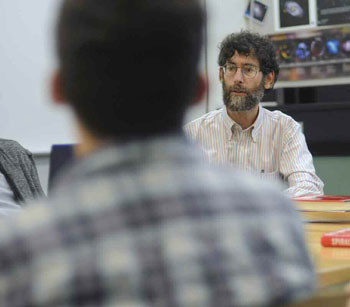In today’s first-year seminar, Nanotechnology in Science and Fiction, students visit a lab in Millikan, where Professor David Tanenbaum grows carbon nanotubes. Particles of iron and molybdenum are combined with methane, hydrogen and argon and heated to 1,000 degrees to create cylindrical molecules, with diameters of one to two nanometers.
 Next, a student-led discussion focuses on I’m Working on That: A Trek from Science Fiction to Science Fact by William Shatner and Chip Walter, and covers topics ranging from wearable computers and biowarfare to cryogenics and virtual reality.
Next, a student-led discussion focuses on I’m Working on That: A Trek from Science Fiction to Science Fact by William Shatner and Chip Walter, and covers topics ranging from wearable computers and biowarfare to cryogenics and virtual reality.
Tanenbaum asks the students to consider whether scientific developments have an effect on science fiction or whether the stories we read lead to innovative ideas for new technology, and the abridged and edited discussion follows:
Tanenbaum: There are a lot of virtual 3D video games where you wear glasses and play them, and you feel pretty much that you’re inside the virtual reality space. … Virtual reality is used in rides where people are in a room that is shaken or accelerated or pushed or pulled, so they think the shaking could be associated with a rocket blasting off or an earthquake. We’ve also read about the idea of live feedback in clothing. If you can put on the right gloves and shirts, those things can give you physical tactile responses. It can feel like someone put his hand on your shoulder, even if it’s just your shirt getting tighter.
Connor: Shatner also has a chapter about wearable computers, and I realized that Apple has done a lot of that by combining the iPhone and an mp3 player and PDA (personal digital assistant).
 Tanenbaum: How many people do you see wearing their earpieces 24 hours a day, seven days a week? I think we’re already there. I want to ask a question that gets at both virtual reality and the wearable computers.
Tanenbaum: How many people do you see wearing their earpieces 24 hours a day, seven days a week? I think we’re already there. I want to ask a question that gets at both virtual reality and the wearable computers.
Can we say anything about the interplay between fiction and reality? Is there a connection between what we see in the science fiction we read and futuristic technologies? For example, the cell phone we have today is modeled—no doubt—on the flip communicator in the 1960’s Star Trek series. Science looked at that and marketing looked at it and said it would be cool to have a communicator. Before the new iPhones and flat tablets, all the sexy phones were flip phones. Do you think the science fiction is inspiring companies to develop the products, or is it the other way around?
Mathieu: It makes a lot of sense that when scientists are growing up they would be influenced by science fiction that they read, and it would definitely have an impact on them.
Mauricio: I think it’s more a mix. I feel that a lot of science fiction writers look at what’s being developed and then come up with applications, which in turn are taken by the science community. A science fiction writer might see a regular telephone and think it would be cool to take that everywhere and build on each other.
Andy: I know a lot of scientific pursuits are not just “Can we make a hologram?” but “Can we make the hologram from Star Wars?” It’s to set a goal for what you want to design.
Hanna: In the article they talk about the back pack, which takes GPS to the next level. It not only knows where you are but nudges you in the right direction, which is one step from the technology we already have.
Tanenbaum: How many have read the preface to The Diamond Age or the book we’re going to read, Katherine Goonan’s Queen City Jazz? In the prefaces and author’s comments, both writers include Eric Drexler [sometimes called the godfather of nanotechnology] in their lists of what inspired them to write their books. We’ve talked a lot about science fiction leading science, and people who say it’s a two-way thing with science sometimes leading science fiction. If you look at Arthur C. Clarke’s novels, the fact that we had a space program and were putting up satellites and people in orbit had a great influence on his being able to write 2001: A Space Odyssey because it was an extension of existing science. That science helped inspire the trajectory for the story. The influences work in both directions.
